Figure 1.
Chemoresistance and potential for research and change in treatment. A, SCLC is very sensitive to first-line chemotherapy, with 60-80% response rate. However, there is almost uniform relapse or progression of disease.Such relapse likely is due to the behavior of the chemoresistant cell population, which may also have enhanced tumorigenic potential (blue-colored cells). B, Opportunities for research and drug development.Patients with newly diagnosed advanced SCLC could be enrolled onto tissue acquisition protocols and their tumors biopsied prior to initiating treatment, facilitating comprehensive molecular studies, including but not limited to genome, transcriptome, proteomic and methylome profiling. Further, these samples can be available for creation of patient derived xenografts (not shown).At the time of progressive or recurrent disease, patients could be approached to undergo repeat biopsy. Evaluation and comparisons of molecular features of paired samples from the same patient could identify pathways of resistance to standard first line therapy, define new biomarkers, and provide opportunities for targeted drug development. Pathways of interest can be evaluated further in genetically engineered mice models (not shown). C,Once agents are found to be of benefit against chemoresistant cells, these can be incorporated into clinical trials and potentially lead to responses and importantly, more durable outcomes. EP, etoposide/platinum.

